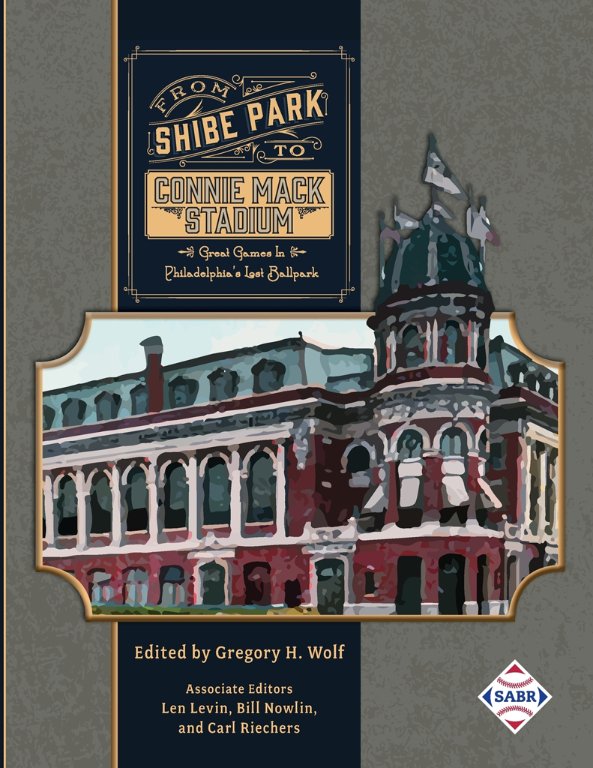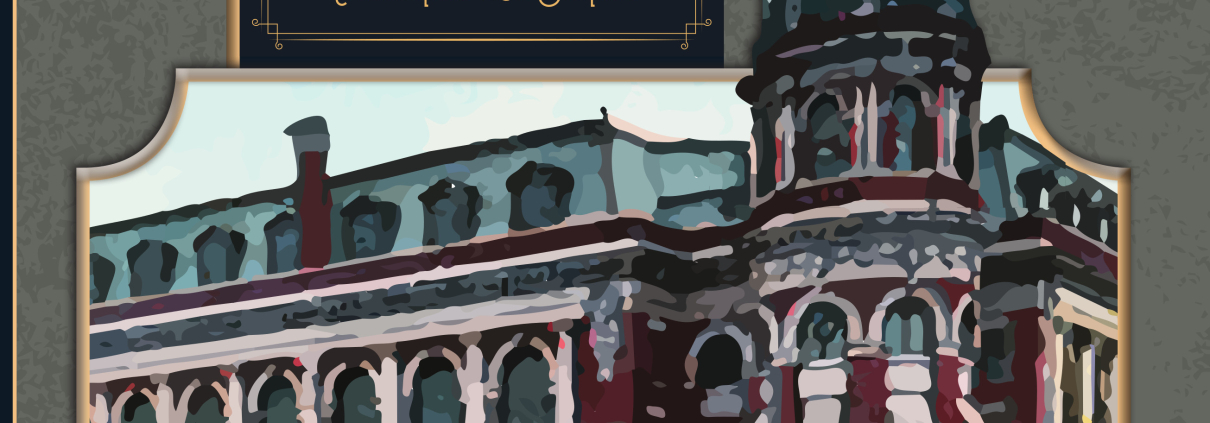April 12, 1909: Shibe Park opens to celebration and sorrow
 Philadelphia resident George McFadden was there bright and early. There would be 6,055 games played in the history of Shibe Park (renamed Connie Mack Stadium decades later), and no one knows how many games Mr. McFadden attended. His claim to fame is that he was the first fan to enter the sparkling new and innovative steel and concrete park. He was the only one in line at 7:00 A.M.; by 8:30 there were 200 lined up behind him, and crammed trains and streetcars were still dropping people off. Soon Lehigh Avenue and 21st Street were lined with fans, a good day for the roving peanut vendors.
Philadelphia resident George McFadden was there bright and early. There would be 6,055 games played in the history of Shibe Park (renamed Connie Mack Stadium decades later), and no one knows how many games Mr. McFadden attended. His claim to fame is that he was the first fan to enter the sparkling new and innovative steel and concrete park. He was the only one in line at 7:00 A.M.; by 8:30 there were 200 lined up behind him, and crammed trains and streetcars were still dropping people off. Soon Lehigh Avenue and 21st Street were lined with fans, a good day for the roving peanut vendors.
Officially, 30,162 entered that day, but the Philadelphia Inquirer estimated another 5,000 “gained admission either by invitation, by scaling the high walls or pressing into the grounds when the gates were rushed by the surging crowds.”1 The immense crowd entered just after noon through the 16 turnstiles. McFadden didn’t scale any walls, but plunked down his 25 cents, turning down a $25 offer for his spot. He was the first to experience what the Inquirer dubbed “the turning of a fresh and scintillating page in the annals of the horsehide sphere.”2
The gates were closed at 3 P.M., shutting out hordes of people still standing in line. It was the good fortune of some to own a home on 20th Street or Somerset Street, where they heard knocking at their doors as disgruntled fans offered them $2 to $5 to let them watch the game from their roofs. Some found a cheaper way by clambering up trees and telegraph poles. Others hurled rocks at the ballpark windows, breaking a few before being chased off by the police. After the pregame ceremonies of bands and anthems, umpire Tim Hurst called “Play ball!” and a new era began. Tommy Connolly also umpired this historic opener. Fans stood behind a rope in the outfield, creating ground-rule-double territory.
In 1908 Boston (75-79-1) and Philadelphia (68-85-4) finished fifth and sixth respectively in the American League. Fred Lake had taken over as Red Sox manager with 40 games to go in 1908, finishing a respectable 22-17. Connie Mack was in his ninth year as manager of the Athletics and had 41 more to go in his Hall of Fame career. Mack sent his veteran ace Eddie Plank to the hill. Plank had suffered a down year in 1908 (14-16 2.17 ERA) after winning 20-plus games in five of the six previous seasons. Boston had traded its ace pitcher, 42-year-old Cy Young, to Cleveland in the offseason for Jack Ryan and Charlie Chech. For this game, Lake turned to Frank Arellanes, with four wins to his name in his rookie campaign in 1908.
Boston went out one-two-three in the top of the first. With one out in the bottom of the inning, Simon Nicholls beat out a slow roller to the mound. Eddie Collins, who 30 years later would be included in the Baseball Hall of Fame’s first induction ceremony, singled over second base. Danny Murphy singled to right to score Nicholls, the first run in the ballpark’s history, to the roar of the crowd. An inspired Collins raced for home but was nailed on strong throws by Doc Gessler in right and relay man Heinie Wagner, who fired the ball to catcher Bill Carrigan. During the inning, the carriage gate in center field was forced open by the crowd, and police had to corral 1,000 people rushing in. The A’s led, 1-0 after one, and the teams were scoreless in the second, noted for Boston third baseman Harry Lord catching Doc Powers’ popup in a sea of scattering musicians.
With two out in the bottom of the third, Collins lined a single to left, then scooted to third on Murphy’s double to center. Harry Davis singled to right, scoring both.3 Boston had a great opportunity in the fourth. Lord smashed the ball to right and would have had a triple were it not for a fan snagging the ball over the rope. Chick Stahl reached when Stuffy McInnis dropped his popup, and a walk to Gessler loaded the bases with no one out. But Tris Speaker fouled out, Wagner popped out, and Jack Thoney grounded out. Then the Red Sox ran themselves out of the fifth inning when with two out Lord was thrown out trying to stretch a hit into a double, “a foolish play at best,” wrote Tim Murnane in the Boston Globe.4
In the bottom of the fifth, Nicholls doubled into the crowd in left field. He moved to third on Collins’s groundout and scored on Murphy’s single past Wagner at short. The Athletics now led, 4-0.
Boston countered with a run in the top of the sixth. Gessler drew a one-out walk. Speaker popped up to third. Wagner’s single to right sent Gessler to third. Thoney doubled into the crowd in right, scoring Gessler. Carrigan’s high fly to right was tracked down by Murphy, so Boston couldn’t chip any more off its deficit, now 4-1. It would not be a shutout for Plank that day. Historically, he ranks fifth all time with 69 shutouts.5 Considering the way the game is played in the twenty-first century, his place will be secure for all time.
The Athletics added a run in the seventh. Topsy Hartsel singled to center and when Nicholls followed with another, Lake pulled Arellanes, who had surrendered 11 hits and four runs. Jack Ryan came in from the bullpen and walked Collins to load the bases. Murphy’s groundball to Chick Stahl at first forced Hartsel at home. With the bases still loaded, Ryan plunked Harry Davis to force in Nicholls, the A’s fifth run. But Ryan avoided further damage as Amos Strunk tapped in front of the plate, where Carrigan scooped up the ball and forced Collins at home. The A’s now led, 5-1, after seven innings.
The Athletics made sure they sent their Opening Day crowd home happy, scoring three more runs in the bottom of the eighth. Powers reached on shortstop Wagner’s error. Plank fouled out to Carrigan, but Hartsel’s grounder caromed off third baseman Lord’s knee and into left field. Ryan walked Nicholls and Collins, the latter pass scoring Powers. Murphy launched a drive down the left-field line to score two more and blow the game open, 8-1.
Boston had a spark in the ninth. With Thoney on second, Carrigan reached on Nicholls’ error. Babe Danzig, pinch-hitting for Ryan, was hit by Plank. The bases were loaded, but Amby McConnell popped out and Lord struck out, the ball disappearing into Powers’ mitt as the A’s won the opening game at Shibe Park, 8-1. Murphy (4-for-5) and Nicholls (3-for-4) were the hitting stars of the day. The A’s put runners on base in six of their eight innings while for Boston, according to Murnane, the game was “like a glass of champagne with the bubbles all burst.”6
As he celebrated that first on the new diamond, no one knew catcher Doc Powers was standing on a baseball field for the last time. No one knew the agonizing pain he was likely experiencing. The Philadelphia Inquirer made only brief mention of Powers having a “seizure” in the seventh inning, but staying in the game.7
Powers died two weeks later, on April 26, at the age of 38. SABR researcher Robert D. Warrington has written an excellent analysis of this incident in the Fall 2014 Baseball Research Journal, which goes beyond the scope of this article.8 A quick Web search today for Doc Powers will return several erroneous books and websites that have disseminated misinformation regarding Powers’ demise: that sandwiches he ate that day caused food poisoning, or that he crashed into a wall attempting to catch a foul ball.9 Neither is based on historical evidence. The cause of death was reported as intussusception, which the Mayo Clinic defines as “a serious condition in which part of the intestine slides into an adjacent part of the intestine.”10 Neither a bad sandwich nor a banging into a wall would have contributed to this condition, which Powers, sadly, a physician who didn’t seek treatment for himself, must have noticed.
Just as thousands crammed into Shibe Park on Opening Day to welcome the new ballpark, so too on April 29 thousands crammed into St. Elizabeth’s Church, to say goodbye to their popular catcher. Fans who had watched from the rooftops now were crowded outside the church’s entrance. A year later, Connie Mack organized a charity game on “Doc Powers Day” at Shibe Park to raise money for Powers’ family. “The park will be a great aid to the city,” Mayor John E. Reyburn said on Opening Day. It was indeed, for the place dubbed “the World’s Greatest Ball Park” was already at the heart of the Philadelphia community, a place for cheers and tears.11
No doubt George McFadden experienced some of both.
Sources
“Great Crowds at Opening Games in American League,” Boston Herald, April 13, 1909: 1, 9.
“Local Fans Do Not Forget the Late Dr. Powers,” Philadelphia Inquirer, July 1, 1910: 1.
“Unusual Tribute Paid to Memory of Dr. Powers,” Philadelphia Inquirer, April 30, 1909: 1.
“When Gates Are Closed Thousands Climb Upon Surrounding Rooftops,” Philadelphia Inquirer, April 13, 1909: 10.
The author also consulted baseball-reference.com and retrosheet.org.
Notes
1 “Greatest Baseball Crowd at Shibe Park Sees Athletics Win Opening Game, 8-1,” Philadelphia Inquirer, April 13, 1909: 1.
2 “Greatest Baseball Crowd at Shibe Park Sees Athletics Win Opening Game, 8-1.”
3 Tim Murnane’s account in the Boston Globe records Collins scoring on Murphy’s double.
4 T.H. Murnane, “Red Sox Run Second Best,” Boston Globe, April 13, 1909: 1.
5 Only Walter Johnson, Pete Alexander, Christy Mathewson, and Cy Young have more shutouts.
6 Murnane: 1.
7 Murnane: 10. The account read: “The only thing that occurred to cast a shadow over the joy of the fans was the seizure of ‘Doc’ Powers with acute gastritis in the seventh inning. The redoubtable catcher, however, refused to abandon his post behind the plate, and though suffering intense agony, pluckily stuck to it until the end of the game. On the verge of collapse, he was taken to the Northwest General Hospital.”
8 Robert D. Warrington, “A Ballpark Opens and a Player Dies: The Converging Fates of Shibe Park and ‘Doc’ Powers,” Baseball Research Journal, Fall 2014. The article is available on the SABR website: sabr.org/research/ballpark-opens-and-ballplayerdies-converging-fates-shibe-park-and-doc-powers Retrieved May 19, 2018.
9 The “sandwich theory” was circulated by sportswriters at the time. While newspaper reports mention Powers catching foul balls twice during the game, neither was reported as something likely to have caused internal injuries.
10 “Intussusception.” Mayo Clinic Diseases & Conditions. mayoclinic.org/diseases-conditions/intussusception/symptoms-causes/syc-20351452 Retrieved May 19, 2018. “This ‘telescoping’ often blocks food or fluid from passing through. Intussusception also cuts off the blood supply to the part of the intestine that’s affected, which can lead to a tear in the bowel (perforation), infection and death of bowel tissue.”
11 “Praise and Admiration Heard on Every Hand,” Philadelphia Inquirer, April 13, 1909: 10.
Additional Stats
Philadelphia Athletics 8
Boston Red Sox 1
Shibe Park
Philadelphia, PA
Box Score + PBP:
Corrections? Additions?
If you can help us improve this game story, contact us.


